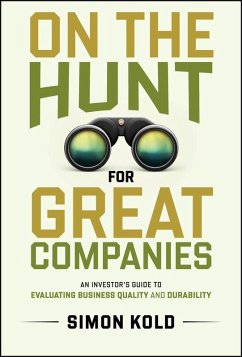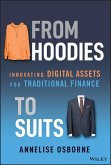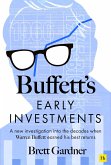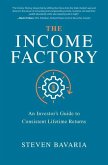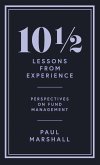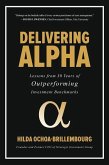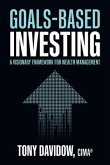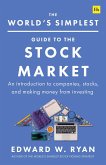Simon Kold
On the Hunt for Great Companies
An Investor's Guide to Evaluating Business Quality and Durability
Simon Kold
On the Hunt for Great Companies
An Investor's Guide to Evaluating Business Quality and Durability
- Gebundenes Buch
- Merkliste
- Auf die Merkliste
- Bewerten Bewerten
- Teilen
- Produkt teilen
- Produkterinnerung
- Produkterinnerung
Praise for ON THE HUNT FOR GREAT COMPANIES "Kold provides an excellent framework to help investors navigate the treacherous path toward investment success. This book will help both sophisticated professional investors and beginners achieve their investment objectives." -- Brian C. Rogers, Retired Chairman and CIO of T. Rowe Price "Long-term fundamental value investing in high-quality companies is the best way to generate consistent returns. Simon Kold has the track record to shed light on the key elements of this strategy." --Kasim Kutay, CEO of Novo Holdings "I've read (and written) my fair…mehr
Andere Kunden interessierten sich auch für
![From Hoodies to Suits From Hoodies to Suits]() Annelise OsborneFrom Hoodies to Suits31,99 €
Annelise OsborneFrom Hoodies to Suits31,99 €![Buffett's Early Investments Buffett's Early Investments]() Brett GardnerBuffett's Early Investments41,99 €
Brett GardnerBuffett's Early Investments41,99 €![The Income Factory The Income Factory]() Steven BavariaThe Income Factory30,99 €
Steven BavariaThe Income Factory30,99 €![101/2 Lessons from Experience: Perspectives on Fund Management 101/2 Lessons from Experience: Perspectives on Fund Management]() Paul Marshall101/2 Lessons from Experience: Perspectives on Fund Management18,99 €
Paul Marshall101/2 Lessons from Experience: Perspectives on Fund Management18,99 €![Delivering Alpha Delivering Alpha]() Hilda Ochoa-BrillembourgDelivering Alpha39,99 €
Hilda Ochoa-BrillembourgDelivering Alpha39,99 €![Goals-Based Investing: A Visionary Framework for Wealth Management Goals-Based Investing: A Visionary Framework for Wealth Management]() Tony DavidowGoals-Based Investing: A Visionary Framework for Wealth Management30,99 €
Tony DavidowGoals-Based Investing: A Visionary Framework for Wealth Management30,99 €![The World's Simplest Guide to the Stock Market The World's Simplest Guide to the Stock Market]() Edward W. RyanThe World's Simplest Guide to the Stock Market17,99 €
Edward W. RyanThe World's Simplest Guide to the Stock Market17,99 €-
-
-
Praise for ON THE HUNT FOR GREAT COMPANIES "Kold provides an excellent framework to help investors navigate the treacherous path toward investment success. This book will help both sophisticated professional investors and beginners achieve their investment objectives." -- Brian C. Rogers, Retired Chairman and CIO of T. Rowe Price "Long-term fundamental value investing in high-quality companies is the best way to generate consistent returns. Simon Kold has the track record to shed light on the key elements of this strategy." --Kasim Kutay, CEO of Novo Holdings "I've read (and written) my fair share of dry, technical tomes on finance. On the Hunt for Great Companies is an inspiring, very practical and wonderfully written book on identifying 'alpha return' companies." -- Thomas Plenborg, Professor at Copenhagen Business School and Chairman of DSV
Hinweis: Dieser Artikel kann nur an eine deutsche Lieferadresse ausgeliefert werden.
Hinweis: Dieser Artikel kann nur an eine deutsche Lieferadresse ausgeliefert werden.
Produktdetails
- Produktdetails
- Verlag: John Wiley & Sons Inc
- Seitenzahl: 336
- Erscheinungstermin: 29. Oktober 2024
- Englisch
- Abmessung: 231mm x 156mm x 33mm
- Gewicht: 642g
- ISBN-13: 9781394285747
- ISBN-10: 1394285744
- Artikelnr.: 70554428
- Herstellerkennzeichnung
- Libri GmbH
- Europaallee 1
- 36244 Bad Hersfeld
- gpsr@libri.de
- Verlag: John Wiley & Sons Inc
- Seitenzahl: 336
- Erscheinungstermin: 29. Oktober 2024
- Englisch
- Abmessung: 231mm x 156mm x 33mm
- Gewicht: 642g
- ISBN-13: 9781394285747
- ISBN-10: 1394285744
- Artikelnr.: 70554428
- Herstellerkennzeichnung
- Libri GmbH
- Europaallee 1
- 36244 Bad Hersfeld
- gpsr@libri.de
SIMON KOLD is the founder of Kold Investments, a Copenhagen-based investment firm. He was previously at Novo Holdings, one of the world's largest investment organizations, with assets worth EUR149 billion. He is one of the few fund managers who also has a degree in theology and had a stint in stand-up comedy.
Acknowledgments xiii
List of Figures xv
List of Tables xix
List of "Let's Sniff Around" xxi
Introduction 1
Part I What Makes Some People Create Exceptional Long- term Per-share
Business Performance? 7
Chapter 1 Passion 9
1.1 Perseverance and Internal Motivations 11
1.2 Focus on All Stakeholder Constituencies 14
1.3 Decision- making Time Horizons 17
1.4 Career Path and Tenure 18
1.5 Retention of People 23
1.6 Authenticity Indicates Passion 25
Chapter 2 Long- term Incentives 35
2.1 Board of Directors 38
2.2 Disincentives 40
2.3 Transactions in Own Shares 42
Chapter 3 Capital Allocation 45
3.1 Value- accretive Buybacks versus Buybacks 47
3.2 Hurdle Rates Should Be Determined by Alternatives 50
3.3 Value Destructive Acquisitions 52
3.4 Unsung Capital Allocators 53
3.5 Metrics and Vocabulary 54
Chapter 4 Reliable Communication 57
4.1 Past Predictions and Ex Post Outcomes 59
4.2 Genuineness as Indicator of Reliability 61
Part II What Makes Competitive Advantages Intense and Durable? 65
Chapter 5 Economies of Scale 73
5.1 Relative Scale and Relevant Market 75
5.2 Prohibitive Costs 76
5.3 Evaluating the Intensity and Durability of Economies of Scale
Advantages 77
5.3.1 General analyses 77
5.3.2 Distribution network density 84
5.3.3 Purchasing scale advantages 86
5.3.4 Marketing scale advantages 88
5.3.5 Production scale advantages 89
5.3.6 Related concepts 90
Chapter 6 Switching Costs 93
6.1 Sticky Customers, Add- on Products, and "Cost of Switching" 95
6.2 Switching Cost Multipliers 97
6.3 Evaluating Intensity of Switching Cost Advantages 98
6.3.1 Costs of switching 98
6.3.2 The arbitrage of switching costs 100
6.3.3 Churn, retention, and cohorts 101
6.3.4 Risk of standardization 104
6.3.5 Risk of excessive value extraction 106
Chapter 7 Network Effects 107
7.1 Boundedness 110
7.2 Critical Mass and Relative Scale 110
7.3 Evaluating the Intensity and Durability of Network Effect Advantages
111
7.3.1 General analyses 111
7.3.2 Protocol network effects 122
7.3.3 Expertise ecosystem network effects 125
7.3.4 Two- sided networks 128
7.3.5 Data network effects 132
Chapter 8 Brand Advantages 135
8.1 "Identity Creating" or "Uncertainty Reducing" 138
8.2 Brand Time Constraints 140
8.3 Luxury Brands 141
8.4 Evaluating Brand Advantages 142
8.4.1 Brand benefits 142
8.4.2 The Lindy effect and brand longevity 143
8.4.3 Geographical boundedness 144
8.4.4 Analytical risk of over- interpreting brand loyalty data 145
8.4.5 Counterfeiting risk 146
8.4.6 Brand experience control risk 146
8.4.7 Brand dilution risk 146
Chapter 9 Proprietary Resources 149
9.1 Favorable Access to Raw Materials 150
9.1.1 Locking up favorable sources 151
9.2 Proprietary Technology 152
9.3 Favorable Locations 154
9.4 Favorable Government Treatment 157
Part III What Makes Some Companies Less Risky and More Valuable Than
Others? 161
Chapter 10 Fair Value Extraction 163
10.1 Tapped and Untapped Pricing Power 165
10.2 Lack of Value Capture 169
10.3 Determinants of Choosing to Withhold Value Extraction 169
10.4 Risk of Extracting Excessive Value from the Supply Side 170
10.5 Evaluating the Risk of Excessive Value Extraction 171
Chapter 11 Staying Power 175
11.1 The Pace of Technological Change in the Industry 178
11.2 Exposure to External Foundational Technological Shifts 181
11.3 Cultural Embeddedness 183
11.4 Cost- effectiveness 184
11.5 Demographic Exposures 185
11.6 Exposure to Industry Channel Changes 185
11.7 Age of Technology/Product Category 186
11.8 Staying Power Versus Growth 187
11.9 Evaluating Staying Power 187
Chapter 12 Proven Business Model 191
12.1 Geographical Replicability 197
12.2 Expansion Investments 199
12.3 Lifetime Unit Economics 201
Chapter 13 Predictable Demand Drivers 205
13.1 Line of Sight of Revenues 208
13.1.1 Backlog of orders 209
13.1.2 Upgrade cycles and replacement sales 209
13.1.3 Contractual recurring business 210
13.1.4 Aftermarket services and spare parts 212
13.2 Predictability of Longer- term Industry Demand 213
13.2.1 Determinants of predictability beyond line of sight 213
Chapter 14 Reinvestment Options 217
14.1 Product Line Expansion 220
14.2 Territorial Expansion 222
14.3 Increased Capacity 223
14.4 Customer Acquisitions and Brand Building Investments 225
14.5 Buying Other Companies 226
14.5.1 Consolidations of fragmented industries 226
14.5.2 Cross- selling with switching cost multipliers 227
14.5.3 Acquihires 228
14.6 Lack of Reinvestment Options 230
Chapter 15 Scalability and Low Incremental Costs 231
15.1 Determinants of Marginal Cost 233
15.2 High Break- even Point 235
15.3 Scalability of Infrastructure 236
15.4 Operational Leverage Magnifies Cyclical Risks and Exit Costs 238
15.5 Capital- light Versus Capital- intensive Businesses 239
Chapter 16 Cyclical Risks 241
16.1 Cyclical Company: Good or Bad? 243
16.2 Degree of Cyclicality 244
16.2.1 Historical cyclicality 246
16.2.2 Historical managerial behavior 247
16.3 Minimizing Analytical Risks Caused by Cyclicality 248
Chapter 17 Other Risks 255
17.1 Dependency Risks 256
17.2 Diversity of Income Streams: Risks and Benefits 257
17.3 Leverage Risks 261
17.4 Geopolitical Risks 264
17.5 Regulatory Risks 265
17.6 "Unknown" Risks 267
Chapter 18 Final Remarks 271
18.1 Analytical Errors 273
18.2 Price Matters 275
18.3 Predicting Quality 276
Appendix: Banana Peels of Inductive Logic 281
Prediction Based on Past Experience 281
Argument from Cause 282
Argument from Generalization 283
Argument from Analogy 284
Argument from Authority 285
Anecdotal Argument 286
About the Author 289
Notes 291
List of Companies Profiled 301
Index 303
List of Figures xv
List of Tables xix
List of "Let's Sniff Around" xxi
Introduction 1
Part I What Makes Some People Create Exceptional Long- term Per-share
Business Performance? 7
Chapter 1 Passion 9
1.1 Perseverance and Internal Motivations 11
1.2 Focus on All Stakeholder Constituencies 14
1.3 Decision- making Time Horizons 17
1.4 Career Path and Tenure 18
1.5 Retention of People 23
1.6 Authenticity Indicates Passion 25
Chapter 2 Long- term Incentives 35
2.1 Board of Directors 38
2.2 Disincentives 40
2.3 Transactions in Own Shares 42
Chapter 3 Capital Allocation 45
3.1 Value- accretive Buybacks versus Buybacks 47
3.2 Hurdle Rates Should Be Determined by Alternatives 50
3.3 Value Destructive Acquisitions 52
3.4 Unsung Capital Allocators 53
3.5 Metrics and Vocabulary 54
Chapter 4 Reliable Communication 57
4.1 Past Predictions and Ex Post Outcomes 59
4.2 Genuineness as Indicator of Reliability 61
Part II What Makes Competitive Advantages Intense and Durable? 65
Chapter 5 Economies of Scale 73
5.1 Relative Scale and Relevant Market 75
5.2 Prohibitive Costs 76
5.3 Evaluating the Intensity and Durability of Economies of Scale
Advantages 77
5.3.1 General analyses 77
5.3.2 Distribution network density 84
5.3.3 Purchasing scale advantages 86
5.3.4 Marketing scale advantages 88
5.3.5 Production scale advantages 89
5.3.6 Related concepts 90
Chapter 6 Switching Costs 93
6.1 Sticky Customers, Add- on Products, and "Cost of Switching" 95
6.2 Switching Cost Multipliers 97
6.3 Evaluating Intensity of Switching Cost Advantages 98
6.3.1 Costs of switching 98
6.3.2 The arbitrage of switching costs 100
6.3.3 Churn, retention, and cohorts 101
6.3.4 Risk of standardization 104
6.3.5 Risk of excessive value extraction 106
Chapter 7 Network Effects 107
7.1 Boundedness 110
7.2 Critical Mass and Relative Scale 110
7.3 Evaluating the Intensity and Durability of Network Effect Advantages
111
7.3.1 General analyses 111
7.3.2 Protocol network effects 122
7.3.3 Expertise ecosystem network effects 125
7.3.4 Two- sided networks 128
7.3.5 Data network effects 132
Chapter 8 Brand Advantages 135
8.1 "Identity Creating" or "Uncertainty Reducing" 138
8.2 Brand Time Constraints 140
8.3 Luxury Brands 141
8.4 Evaluating Brand Advantages 142
8.4.1 Brand benefits 142
8.4.2 The Lindy effect and brand longevity 143
8.4.3 Geographical boundedness 144
8.4.4 Analytical risk of over- interpreting brand loyalty data 145
8.4.5 Counterfeiting risk 146
8.4.6 Brand experience control risk 146
8.4.7 Brand dilution risk 146
Chapter 9 Proprietary Resources 149
9.1 Favorable Access to Raw Materials 150
9.1.1 Locking up favorable sources 151
9.2 Proprietary Technology 152
9.3 Favorable Locations 154
9.4 Favorable Government Treatment 157
Part III What Makes Some Companies Less Risky and More Valuable Than
Others? 161
Chapter 10 Fair Value Extraction 163
10.1 Tapped and Untapped Pricing Power 165
10.2 Lack of Value Capture 169
10.3 Determinants of Choosing to Withhold Value Extraction 169
10.4 Risk of Extracting Excessive Value from the Supply Side 170
10.5 Evaluating the Risk of Excessive Value Extraction 171
Chapter 11 Staying Power 175
11.1 The Pace of Technological Change in the Industry 178
11.2 Exposure to External Foundational Technological Shifts 181
11.3 Cultural Embeddedness 183
11.4 Cost- effectiveness 184
11.5 Demographic Exposures 185
11.6 Exposure to Industry Channel Changes 185
11.7 Age of Technology/Product Category 186
11.8 Staying Power Versus Growth 187
11.9 Evaluating Staying Power 187
Chapter 12 Proven Business Model 191
12.1 Geographical Replicability 197
12.2 Expansion Investments 199
12.3 Lifetime Unit Economics 201
Chapter 13 Predictable Demand Drivers 205
13.1 Line of Sight of Revenues 208
13.1.1 Backlog of orders 209
13.1.2 Upgrade cycles and replacement sales 209
13.1.3 Contractual recurring business 210
13.1.4 Aftermarket services and spare parts 212
13.2 Predictability of Longer- term Industry Demand 213
13.2.1 Determinants of predictability beyond line of sight 213
Chapter 14 Reinvestment Options 217
14.1 Product Line Expansion 220
14.2 Territorial Expansion 222
14.3 Increased Capacity 223
14.4 Customer Acquisitions and Brand Building Investments 225
14.5 Buying Other Companies 226
14.5.1 Consolidations of fragmented industries 226
14.5.2 Cross- selling with switching cost multipliers 227
14.5.3 Acquihires 228
14.6 Lack of Reinvestment Options 230
Chapter 15 Scalability and Low Incremental Costs 231
15.1 Determinants of Marginal Cost 233
15.2 High Break- even Point 235
15.3 Scalability of Infrastructure 236
15.4 Operational Leverage Magnifies Cyclical Risks and Exit Costs 238
15.5 Capital- light Versus Capital- intensive Businesses 239
Chapter 16 Cyclical Risks 241
16.1 Cyclical Company: Good or Bad? 243
16.2 Degree of Cyclicality 244
16.2.1 Historical cyclicality 246
16.2.2 Historical managerial behavior 247
16.3 Minimizing Analytical Risks Caused by Cyclicality 248
Chapter 17 Other Risks 255
17.1 Dependency Risks 256
17.2 Diversity of Income Streams: Risks and Benefits 257
17.3 Leverage Risks 261
17.4 Geopolitical Risks 264
17.5 Regulatory Risks 265
17.6 "Unknown" Risks 267
Chapter 18 Final Remarks 271
18.1 Analytical Errors 273
18.2 Price Matters 275
18.3 Predicting Quality 276
Appendix: Banana Peels of Inductive Logic 281
Prediction Based on Past Experience 281
Argument from Cause 282
Argument from Generalization 283
Argument from Analogy 284
Argument from Authority 285
Anecdotal Argument 286
About the Author 289
Notes 291
List of Companies Profiled 301
Index 303
Acknowledgments xiii
List of Figures xv
List of Tables xix
List of "Let's Sniff Around" xxi
Introduction 1
Part I What Makes Some People Create Exceptional Long- term Per-share
Business Performance? 7
Chapter 1 Passion 9
1.1 Perseverance and Internal Motivations 11
1.2 Focus on All Stakeholder Constituencies 14
1.3 Decision- making Time Horizons 17
1.4 Career Path and Tenure 18
1.5 Retention of People 23
1.6 Authenticity Indicates Passion 25
Chapter 2 Long- term Incentives 35
2.1 Board of Directors 38
2.2 Disincentives 40
2.3 Transactions in Own Shares 42
Chapter 3 Capital Allocation 45
3.1 Value- accretive Buybacks versus Buybacks 47
3.2 Hurdle Rates Should Be Determined by Alternatives 50
3.3 Value Destructive Acquisitions 52
3.4 Unsung Capital Allocators 53
3.5 Metrics and Vocabulary 54
Chapter 4 Reliable Communication 57
4.1 Past Predictions and Ex Post Outcomes 59
4.2 Genuineness as Indicator of Reliability 61
Part II What Makes Competitive Advantages Intense and Durable? 65
Chapter 5 Economies of Scale 73
5.1 Relative Scale and Relevant Market 75
5.2 Prohibitive Costs 76
5.3 Evaluating the Intensity and Durability of Economies of Scale
Advantages 77
5.3.1 General analyses 77
5.3.2 Distribution network density 84
5.3.3 Purchasing scale advantages 86
5.3.4 Marketing scale advantages 88
5.3.5 Production scale advantages 89
5.3.6 Related concepts 90
Chapter 6 Switching Costs 93
6.1 Sticky Customers, Add- on Products, and "Cost of Switching" 95
6.2 Switching Cost Multipliers 97
6.3 Evaluating Intensity of Switching Cost Advantages 98
6.3.1 Costs of switching 98
6.3.2 The arbitrage of switching costs 100
6.3.3 Churn, retention, and cohorts 101
6.3.4 Risk of standardization 104
6.3.5 Risk of excessive value extraction 106
Chapter 7 Network Effects 107
7.1 Boundedness 110
7.2 Critical Mass and Relative Scale 110
7.3 Evaluating the Intensity and Durability of Network Effect Advantages
111
7.3.1 General analyses 111
7.3.2 Protocol network effects 122
7.3.3 Expertise ecosystem network effects 125
7.3.4 Two- sided networks 128
7.3.5 Data network effects 132
Chapter 8 Brand Advantages 135
8.1 "Identity Creating" or "Uncertainty Reducing" 138
8.2 Brand Time Constraints 140
8.3 Luxury Brands 141
8.4 Evaluating Brand Advantages 142
8.4.1 Brand benefits 142
8.4.2 The Lindy effect and brand longevity 143
8.4.3 Geographical boundedness 144
8.4.4 Analytical risk of over- interpreting brand loyalty data 145
8.4.5 Counterfeiting risk 146
8.4.6 Brand experience control risk 146
8.4.7 Brand dilution risk 146
Chapter 9 Proprietary Resources 149
9.1 Favorable Access to Raw Materials 150
9.1.1 Locking up favorable sources 151
9.2 Proprietary Technology 152
9.3 Favorable Locations 154
9.4 Favorable Government Treatment 157
Part III What Makes Some Companies Less Risky and More Valuable Than
Others? 161
Chapter 10 Fair Value Extraction 163
10.1 Tapped and Untapped Pricing Power 165
10.2 Lack of Value Capture 169
10.3 Determinants of Choosing to Withhold Value Extraction 169
10.4 Risk of Extracting Excessive Value from the Supply Side 170
10.5 Evaluating the Risk of Excessive Value Extraction 171
Chapter 11 Staying Power 175
11.1 The Pace of Technological Change in the Industry 178
11.2 Exposure to External Foundational Technological Shifts 181
11.3 Cultural Embeddedness 183
11.4 Cost- effectiveness 184
11.5 Demographic Exposures 185
11.6 Exposure to Industry Channel Changes 185
11.7 Age of Technology/Product Category 186
11.8 Staying Power Versus Growth 187
11.9 Evaluating Staying Power 187
Chapter 12 Proven Business Model 191
12.1 Geographical Replicability 197
12.2 Expansion Investments 199
12.3 Lifetime Unit Economics 201
Chapter 13 Predictable Demand Drivers 205
13.1 Line of Sight of Revenues 208
13.1.1 Backlog of orders 209
13.1.2 Upgrade cycles and replacement sales 209
13.1.3 Contractual recurring business 210
13.1.4 Aftermarket services and spare parts 212
13.2 Predictability of Longer- term Industry Demand 213
13.2.1 Determinants of predictability beyond line of sight 213
Chapter 14 Reinvestment Options 217
14.1 Product Line Expansion 220
14.2 Territorial Expansion 222
14.3 Increased Capacity 223
14.4 Customer Acquisitions and Brand Building Investments 225
14.5 Buying Other Companies 226
14.5.1 Consolidations of fragmented industries 226
14.5.2 Cross- selling with switching cost multipliers 227
14.5.3 Acquihires 228
14.6 Lack of Reinvestment Options 230
Chapter 15 Scalability and Low Incremental Costs 231
15.1 Determinants of Marginal Cost 233
15.2 High Break- even Point 235
15.3 Scalability of Infrastructure 236
15.4 Operational Leverage Magnifies Cyclical Risks and Exit Costs 238
15.5 Capital- light Versus Capital- intensive Businesses 239
Chapter 16 Cyclical Risks 241
16.1 Cyclical Company: Good or Bad? 243
16.2 Degree of Cyclicality 244
16.2.1 Historical cyclicality 246
16.2.2 Historical managerial behavior 247
16.3 Minimizing Analytical Risks Caused by Cyclicality 248
Chapter 17 Other Risks 255
17.1 Dependency Risks 256
17.2 Diversity of Income Streams: Risks and Benefits 257
17.3 Leverage Risks 261
17.4 Geopolitical Risks 264
17.5 Regulatory Risks 265
17.6 "Unknown" Risks 267
Chapter 18 Final Remarks 271
18.1 Analytical Errors 273
18.2 Price Matters 275
18.3 Predicting Quality 276
Appendix: Banana Peels of Inductive Logic 281
Prediction Based on Past Experience 281
Argument from Cause 282
Argument from Generalization 283
Argument from Analogy 284
Argument from Authority 285
Anecdotal Argument 286
About the Author 289
Notes 291
List of Companies Profiled 301
Index 303
List of Figures xv
List of Tables xix
List of "Let's Sniff Around" xxi
Introduction 1
Part I What Makes Some People Create Exceptional Long- term Per-share
Business Performance? 7
Chapter 1 Passion 9
1.1 Perseverance and Internal Motivations 11
1.2 Focus on All Stakeholder Constituencies 14
1.3 Decision- making Time Horizons 17
1.4 Career Path and Tenure 18
1.5 Retention of People 23
1.6 Authenticity Indicates Passion 25
Chapter 2 Long- term Incentives 35
2.1 Board of Directors 38
2.2 Disincentives 40
2.3 Transactions in Own Shares 42
Chapter 3 Capital Allocation 45
3.1 Value- accretive Buybacks versus Buybacks 47
3.2 Hurdle Rates Should Be Determined by Alternatives 50
3.3 Value Destructive Acquisitions 52
3.4 Unsung Capital Allocators 53
3.5 Metrics and Vocabulary 54
Chapter 4 Reliable Communication 57
4.1 Past Predictions and Ex Post Outcomes 59
4.2 Genuineness as Indicator of Reliability 61
Part II What Makes Competitive Advantages Intense and Durable? 65
Chapter 5 Economies of Scale 73
5.1 Relative Scale and Relevant Market 75
5.2 Prohibitive Costs 76
5.3 Evaluating the Intensity and Durability of Economies of Scale
Advantages 77
5.3.1 General analyses 77
5.3.2 Distribution network density 84
5.3.3 Purchasing scale advantages 86
5.3.4 Marketing scale advantages 88
5.3.5 Production scale advantages 89
5.3.6 Related concepts 90
Chapter 6 Switching Costs 93
6.1 Sticky Customers, Add- on Products, and "Cost of Switching" 95
6.2 Switching Cost Multipliers 97
6.3 Evaluating Intensity of Switching Cost Advantages 98
6.3.1 Costs of switching 98
6.3.2 The arbitrage of switching costs 100
6.3.3 Churn, retention, and cohorts 101
6.3.4 Risk of standardization 104
6.3.5 Risk of excessive value extraction 106
Chapter 7 Network Effects 107
7.1 Boundedness 110
7.2 Critical Mass and Relative Scale 110
7.3 Evaluating the Intensity and Durability of Network Effect Advantages
111
7.3.1 General analyses 111
7.3.2 Protocol network effects 122
7.3.3 Expertise ecosystem network effects 125
7.3.4 Two- sided networks 128
7.3.5 Data network effects 132
Chapter 8 Brand Advantages 135
8.1 "Identity Creating" or "Uncertainty Reducing" 138
8.2 Brand Time Constraints 140
8.3 Luxury Brands 141
8.4 Evaluating Brand Advantages 142
8.4.1 Brand benefits 142
8.4.2 The Lindy effect and brand longevity 143
8.4.3 Geographical boundedness 144
8.4.4 Analytical risk of over- interpreting brand loyalty data 145
8.4.5 Counterfeiting risk 146
8.4.6 Brand experience control risk 146
8.4.7 Brand dilution risk 146
Chapter 9 Proprietary Resources 149
9.1 Favorable Access to Raw Materials 150
9.1.1 Locking up favorable sources 151
9.2 Proprietary Technology 152
9.3 Favorable Locations 154
9.4 Favorable Government Treatment 157
Part III What Makes Some Companies Less Risky and More Valuable Than
Others? 161
Chapter 10 Fair Value Extraction 163
10.1 Tapped and Untapped Pricing Power 165
10.2 Lack of Value Capture 169
10.3 Determinants of Choosing to Withhold Value Extraction 169
10.4 Risk of Extracting Excessive Value from the Supply Side 170
10.5 Evaluating the Risk of Excessive Value Extraction 171
Chapter 11 Staying Power 175
11.1 The Pace of Technological Change in the Industry 178
11.2 Exposure to External Foundational Technological Shifts 181
11.3 Cultural Embeddedness 183
11.4 Cost- effectiveness 184
11.5 Demographic Exposures 185
11.6 Exposure to Industry Channel Changes 185
11.7 Age of Technology/Product Category 186
11.8 Staying Power Versus Growth 187
11.9 Evaluating Staying Power 187
Chapter 12 Proven Business Model 191
12.1 Geographical Replicability 197
12.2 Expansion Investments 199
12.3 Lifetime Unit Economics 201
Chapter 13 Predictable Demand Drivers 205
13.1 Line of Sight of Revenues 208
13.1.1 Backlog of orders 209
13.1.2 Upgrade cycles and replacement sales 209
13.1.3 Contractual recurring business 210
13.1.4 Aftermarket services and spare parts 212
13.2 Predictability of Longer- term Industry Demand 213
13.2.1 Determinants of predictability beyond line of sight 213
Chapter 14 Reinvestment Options 217
14.1 Product Line Expansion 220
14.2 Territorial Expansion 222
14.3 Increased Capacity 223
14.4 Customer Acquisitions and Brand Building Investments 225
14.5 Buying Other Companies 226
14.5.1 Consolidations of fragmented industries 226
14.5.2 Cross- selling with switching cost multipliers 227
14.5.3 Acquihires 228
14.6 Lack of Reinvestment Options 230
Chapter 15 Scalability and Low Incremental Costs 231
15.1 Determinants of Marginal Cost 233
15.2 High Break- even Point 235
15.3 Scalability of Infrastructure 236
15.4 Operational Leverage Magnifies Cyclical Risks and Exit Costs 238
15.5 Capital- light Versus Capital- intensive Businesses 239
Chapter 16 Cyclical Risks 241
16.1 Cyclical Company: Good or Bad? 243
16.2 Degree of Cyclicality 244
16.2.1 Historical cyclicality 246
16.2.2 Historical managerial behavior 247
16.3 Minimizing Analytical Risks Caused by Cyclicality 248
Chapter 17 Other Risks 255
17.1 Dependency Risks 256
17.2 Diversity of Income Streams: Risks and Benefits 257
17.3 Leverage Risks 261
17.4 Geopolitical Risks 264
17.5 Regulatory Risks 265
17.6 "Unknown" Risks 267
Chapter 18 Final Remarks 271
18.1 Analytical Errors 273
18.2 Price Matters 275
18.3 Predicting Quality 276
Appendix: Banana Peels of Inductive Logic 281
Prediction Based on Past Experience 281
Argument from Cause 282
Argument from Generalization 283
Argument from Analogy 284
Argument from Authority 285
Anecdotal Argument 286
About the Author 289
Notes 291
List of Companies Profiled 301
Index 303

